(SciTechDaily) Stanford University researchers have developed a key experimental device for future quantum physics-based technologies that borrows a page from current, everyday mechanical devices. IQT-News summarizes here the announcement about the research.
Acoustic devices use mechanical motion to perform useful functions. They are dependable, small, long-lasting, and efficient. The mechanical oscillator is a prime example of such a device. When displaced by a force – such as sound, for example – the device’s components begin to move back and forth about their original position. Creating this periodic motion is a convenient way to track time, filter signals, and detect motion in everyday devices such as phones, computers, and watches.
Researchers have sought to bring the benefits of mechanical systems down into the extremely small scales of the mysterious quantum realm, where atoms delicately interact and behave in counterintuitive ways. Toward this end, Stanford researchers led by Amir Safavi-Naeini have demonstrated new capabilities by coupling tiny nanomechanical oscillators with a type of circuit that can store and process energy in the form of a qubit, or quantum “bit” of information. Using the device’s qubit, the researchers can manipulate the quantum state of mechanical oscillators, generating the kinds of quantum mechanical effects that could someday empower advanced computing and ultraprecise sensing systems.
“With this device, we’ve shown an important next step in trying to build quantum computers and other useful quantum devices based on mechanical systems,” said Safavi-Naeini, an associate professor in the Department of Applied Physics at Stanford’s School of Humanities and Sciences. Safavi-Naeini is senior author of a new study published on April 20, 2022, in the journal Nature describing the findings. “We’re in essence looking to build ‘mechanical quantum mechanical’ systems,” he said.
Sandra K. Helsel, Ph.D. has been researching and reporting on frontier technologies since 1990. She has her Ph.D. from the University of Arizona.
